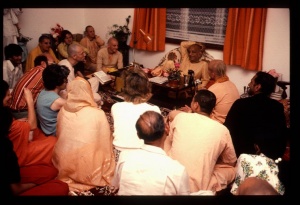CC Adi 5.226

A.C. Bhaktivedanta Swami Prabhupada
TEXT 226
- sei aparādhe tāra nāhika nistāra
- ghora narakete paḍe, ki baliba āra
SYNONYMS
sei aparādhe—by that offense; tāra—his; nāhika—there is not; nistāra—deliverance; ghora—terrible; narakete—in a hellish condition; paḍe—falls down; ki baliba—what will I say; āra—more.
TRANSLATION
For that offense, he cannot be liberated. Rather, he will fall into a terrible hellish condition. What more should I say?
PURPORT
In his Bhakti-sandarbha Jīva Gosvāmī has stated that those who are actually very serious about devotional service do not differentiate between the form of the Lord made of clay, metal, stone or wood and the original form of the Lord. In the material world a person and his photograph, picture or statue are different. But the statue of Lord Kṛṣṇa and Kṛṣṇa Himself, the Supreme Personality of Godhead, are not different, because the Lord is absolute. What we call stone, wood and metal are energies of the Supreme Lord, and energies are never separate from the energetic. As we have several times explained, no one can separate the sunshine energy from the energetic sun. Therefore material energy may appear separate from the Lord, but transcendentally it is nondifferent from the Lord.
The Lord can appear anywhere and everywhere because His diverse energies are distributed everywhere like sunshine. We should therefore understand whatever we see to be the energy of the Supreme Lord and should not differentiate between the Lord and His arcā form made from clay, metal, wood or paint. Even if one has not developed this consciousness, one should accept it theoretically from the instructions of the spiritual master and should worship the arcā-mūrti, or form of the Lord in the temple, as nondifferent from the Lord.
The Padma Purāṇa specifically mentions that anyone who thinks the form of the Lord in the temple to be made of wood, stone or metal is certainly in a hellish condition. Impersonalists are against the worship of the Lord’s form in the temple, and there is even a group of people who pass as Hindus but condemn such worship. Their so-called acceptance of the Vedas has no meaning, for all the ācāryas, even the impersonalist Śaṅkarācārya, have recommended the worship of the transcendental form of the Lord. Impersonalists like Śaṅkarācārya recommend the worship of five forms, known as pañcopāsanā, which include Lord Viṣṇu. Vaiṣṇavas, however, worship the forms of Lord Viṣṇu in His varied manifestations, such as Rādhā-Kṛṣṇa, Lakṣmī-Nārāyaṇa, Sītā-Rāma and Rukmiṇī-Kṛṣṇa. Māyāvādīs admit that worship of the Lord’s form is required in the beginning, but they think that in the end everything is impersonal. Therefore, since they are ultimately against worship of the Lord’s form, Lord Śrī Caitanya Mahāprabhu has described them as offenders.
Śrīmad-Bhāgavatam has condemned those who think the body to be the self as bhauma ijya-dhīḥ. Bhauma means earth, and ijya-dhīḥ means worshiper. There are two kinds of bhauma ijya-dhīḥ: those who worship the land of their birth, such as nationalists, who make many sacrifices for the motherland, and those who condemn the worship of the form of the Lord. One should not worship the planet earth or land of his birth, nor should one condemn the form of the Lord, which is manifested in metal or wood for our facility. Material things are also the energy of the Supreme Lord.